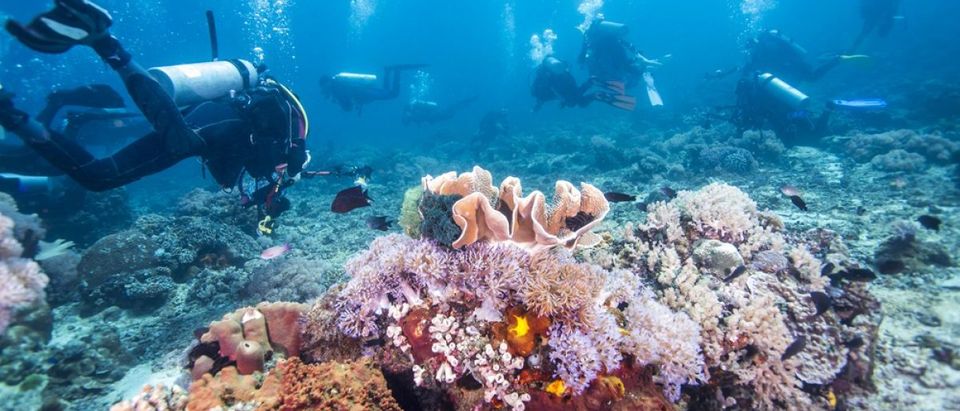Coral ecologist Laurie Raymundo said she just couldn’t handle seeing coral reefs near Guam undergo bleaching attributed to man-made global warming.
“I consider myself to be fairly objective and logical about science,” Raymundo wrote on Facebook after a recent dive in Guam’s Tumon Bay, “But sometimes that approach fails me.”
“Today, for the first time in the 50 years I’ve been in the water, I cried for an hour, right into my mask, as I witnessed the extent to which our lovely Tumon Bay corals were bleaching and dying,” Raymundo wrote.
Guam’s reefs, like many around the world, are undergoing “bleaching” as ocean temperatures rise. Bleaching became particularly acute last year because of the incredibly strong El Nino warming event that boosted ocean temperatures across the tropical Pacific Ocean.
Scientists and environmentalists often point to Australia’s Great Barrier Reef as an example of how man-made global warming is devastating the world’s reefs. In April, 93 percent of the Great Barrier Reef was bleached, said scientists.
Raymundo isn’t the first scientist to reportedly cry when witnessing the extent of coral bleaching. Terry Hughes, the lead coral reef researcher at Australia’s James Cook University, admitted to crying with students when he published his study on Great Barrier Reef bleaching.
I showed the results of aerial surveys of #bleaching on the #GreatBarrierReef to my students, And then we wept. pic.twitter.com/bry5cMmzdn
— Terry Hughes (@ProfTerryHughes) April 19, 2016
Coral bleaching can occur when ocean temperatures rise. This causes reefs to “expel the algae (zooxanthellae) living in their tissues causing the coral to turn completely white,” according to the National Oceanic and Atmospheric Administration (NOAA). Cold water can also cause bleaching.
Media coverage of coral bleaching has focused on doom and gloom scenarios predicting a massive die-off of the world’s coral reefs. A 2015 study, however, found such predictions to be the product of hype.
“There are a lot of conversations around meetings about the excess doom and gloom in our reporting of ocean health, but perhaps this is the first paper to bring these concerns out of the privacy of peer conversations,” Carlos Duarte, a marine biologist at the University of Western Australia, told Nature.
Duarte found many alarmist media headlines didn’t match up with the underlying science. Duarte also found that marine scientists “may not have remained sufficiently sceptical” when relaying their findings to reporters.
“This is a silent movement, as there is a lot of peer pressure against voicing those concerns openly, so my co-authors and I expect significant heat upon us to be derived from our paper,” said Duarte.
An Australian scientist was censured by his university for exposing his colleagues for using a misleading photo to hype coral bleaching.
The Centre of Excellence for Coral Studies and the Great Barrier Reef Marine Park Authority published photos in a report contrasting images of the Great Barrier Reef in the 19th Century and 1994 as evidence man-made global warming was driving coral bleaching.
Scientist Paul Ridd discovered the photos were misleading. He said it’s not possible to say what killed parts of the reef featured in the 1994 photo.
“These photographs are a big deal as they are plastered right across the internet and used very widely to claim damage,” Ridd said in June.
“In fact, there are literally hundreds of square kilometres of dead reef-flat on the Great Barrier Reef which was killed due to the slow sea-level fall of about a meter that has occurred over the last 5000 years,” Ridd said.
“My point is not that they have probably got this completely wrong but rather what are the quality assurance measures they take to try to ensure they are not telling a misleading story?” Ridd said.
Follow Michael on Facebook and Twitter
All content created by the Daily Caller News Foundation, an independent and nonpartisan newswire service, is available without charge to any legitimate news publisher that can provide a large audience. All republished articles must include our logo, our reporter’s byline and their DCNF affiliation. For any questions about our guidelines or partnering with us, please contact licensing@dailycallernewsfoundation.org.


